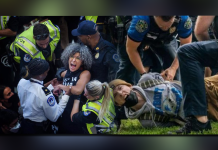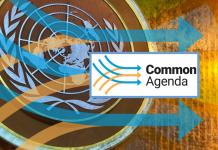By Igor Derysh
Mass killers and violent militias have echoed President Donald Trump’s rhetoric for years, but his stoking of dangerous conspiracy theories and tacit approval of extremists have resulted in «countless threats of violence and looming civil war» ahead of the election, according to a new report from the gun control advocacy group Everytown shared exclusively with Salon.
The report links the National Rifle Association’s (NRA) «potentially radicalizing messaging» to the «gun rights fanaticsm» driving the modern militia movement, which was further emboldened by Trump’s «conspiratorial rhetoric.» The trend was on full display at the first presidential debate when Trump, who said there were «fine people» on both sides of the deadly white supremacist march in Charlottesville, Va., urged the violent extremist group the Proud Boys to «stand back, and stand by» when he was asked to condemn white supremacy. Trump denounced white supremacy days later, but not before his message was celebrated by the far-right and emblazoned onto the Proud Boys’ logo.
«The fact of the matter is the commander-in-chief of the United States, who is supposed to be doing everything in his power to protect the American people, just made them less safe from the debate stage,» Nick Suplina, the managing director for law and policy at Everytown, said in an exclusive interview with Salon.
«The rise of extreme right violence is thanks in no small part to the fear mongering and enabling by the NRA, and more recently to Trump in encouraging these groups . . . including his statement to ‘stand back, and stand by,'» Suplina continued.
«Gun extremism really is the central organizing principle for much of the extreme right in America — and that’s from the NRA, to private militia groups, to even some of the rhetoric we hear from the White House,» Justin Wagner, Everytown’s senior investigations counsel, added. «And there really are clear historical parallels to the current moment and the period in the 1990s leading up to the Oklahoma City bombing . . . The only difference is we didn’t have a president in the ’90s who was willing to validate threats from the White House.»
Wagner faulted the media for framing Trump’s emboldening of white supremacists as a «potential» problem despite numerous instances of deadly violence. One-third of the 20 deadliest shootings in the past decade were motivated by some form of white supremacy, according to Everytown’s analysis.
«It’s not academic,» he said. «It’s already happened.»
In 2018, Trump and his allies stoked fear about a «caravan» of Central American migrants heading to the U.S. Trump, Republican lawmakers and NRA TV pushed a conspiracy theory that Jewish billionaire George Soros, a Democratic megadonor, was behind the caravan in an apparent attempt to influence the elections.
Eight days later, a white supremacist killed 11 people and wounded six others at the Tree of Life synagogue in Pittsburgh after accusing a Jewish nonprofit that aids refugees of «bring[ing] invaders in that kill our people.»
«They’re committing genocide to my people,» the alleged gunman reportedly told an officer during a shootout with police. «I just want to kill Jews.»
The shooter had for years «harbored conspiratorial views» about the government, the Everytown report notes, reportedly worrying that United Nations «blue hats» were coming for his guns. It was a conspiracy theory boosted for years by NRA chief Wayne LaPierre, who warned in one of his books that «an armed U.N. platoon of blue helmets can knock on your door to take your guns.»
Trump has also repeatedly warned of an «invasion» by «illegal immigrants,» a call which was echoed by the NRA and a white nationalist who killed 20 people and wounded dozens of others at a Walmart in El Paso, Texas, last year. The alleged shooter told police that he had targeted Latinos in the rampage and wrote in his «manifesto» that «this attack is a response to the Hispanic invasion of Texas.»
«Rhetoric and language has consequences, and when leaders say things and validate extremist belief and conspiracies, it can have real-life consequences,» Wagner told Salon. «I think El Paso is an excellent example of that where you had both the gun lobby and the president peddling conspiracies and peddling fear-mongering, and I think the shooter’s manifesto speaks for itself.»
Top Trump administration officials have repeatedly acknowledged the growing threat posed by white supremacist extremism in spite of pushback from the White House.
The Department of Homeland Security, for the first time since its inception after the 9/11 attacks, called white supremacist extremism «one of the most potent forces driving domestic terrorism.» Two months later, FBI Director Christopher Wray testified to a Senate committee that the majority of the bureau’s investigations into domestic terror attacks were «fueled by some kind of white supremacy.» Last month, Wray reiterated to a House committee that the majority of «racially motivated violent extremism» was driven by white supremacists.
But the threat of violent extremists is not limited to white supremacists. A report from the Anti-Defamation League found that anti-government extremists were responsible for roughly the same number of terror attacks and plots as white supremacists between 1993 and 2017.
Domestic extremists have killed more people than any other group, including those inspired by radical jihadist ideology, according to a report from the think tank New America. The threat has grown substantially over the past six years, according to a report from the Center for Strategic and International Studies, with far-right attacks accounting for two-thirds of domestic terror attacks and plots last year.
How the NRA fueled the rise of the militia movement
Guns have «overwhelmingly» been the weapon of choice for far-right extremists, and the Department of Homeland Security and FBI concluded in 2017 that «firearms likely will continue to pose the greatest threat of lethal violence by [white supremacist extremists] due to their availability and ease of use.» The rise of homemade untraceable «ghost guns» have made it even easier for extremists to obtain deadly weapons.
«It’s important that we recognize the synergy here between the extreme right and the NRA is manifest in the very gun laws that allow the extreme right to arm itself so extensively and so easily,» Suplina said. «This isn’t just about common language and rhetoric and flaming the fire of hate, but it is also enabling it practically.»
Even as access to guns has grown, the NRA and other gun groups have peddled conspiracy theories built on an «unrelenting ‘Us vs. Them’ narrative, telling its members that they are under constant threat from dangers ranging from roving bands of criminals to would-be authoritarians on the political left,» the Everytown report says.
The extreme right has also thrived on conspiracies and distrust, the report notes. For white supremacists, the opponent is people of color or Jewish people «whom they believe are carrying out a genocidal plan against white people.» For anti-government extremists, the opponents are government institutions and the political left. «The lack of explicit racial animus within anti-government activism does not mean that racism is not a feature of the movement, which includes broad acceptance of Islamophobic and anti-immigrant sentiments,» the report says.
In the early ’90s, gun lobby leader Larry Pratt reportedly urged white supremacists in Colorado to form «small paramilitary units to violently resolve social problems, such as drug use, interracial marriage and the abortion of white babies,» according to the report.
LaPierre in the mid-’90s defended white supremacists after the infamous Ruby Ridge standoff and called for people to «take whatever measures necessary, including force, to abolish oppressive government.» He railed about alleged «abuses» by the Bureau of Alcohol, Tobacco, Firearms and Explosives (ATF) after the Ruby Ridge and Waco standoffs.
In 1995, LaPierre called federal agents «jack-booted government thugs» and warned followers in a letter that it was no longer «unthinkable for federal agents wearing Nazi bucket helmets and black storm trooper uniforms to attack law-abiding citizens.»
Six days after LaPierre’s letter, Timothy McVeigh bombed a federal building in Oklahoma City, killing 168 people, because it housed an ATF office. McVeigh, who had been an NRA member until the year before the attack, stamped a letter to a member of Congress with an «I’m the NRA» sticker. McVeigh was «fanatical» about the right to bear arms, a friend said at the time, and «echoed the NRA’s rhetoric and paranoia,» the Everytown report says.
After the attack, LaPierre claimed the NRA had «no relationship» with the militia movement, but «a month after the bombing, the NRA held its 1995 annual meeting, at which it adopted a resolution saying that while it did not support violent revolution, it would not ‘contemplate discouraging’ people from forming or participating in militias,» the report says. The NRA also presented an award to the leader of a California militia at the meeting.
«I’m a lawyer, but I had a hell of a hard time parsing that language to discover the NRA’s true position on militias,» former NRA lobbyist Richard Feldman later wrote. «Is it possible that’s what they intended?»
The report goes on to link NRA board members, like Ted Nugent and Neal Knox, to militia groups.
«That really fostered the anger and the fear of those that are already radicalized — and that’s when you have the risk of violence,» Wagner said. «An important aspect for this report is calling out the NRA for winking and nodding at many of these groups and ideas and giving their audience power and potentially inflating extremism.»
Rise of armed extreme right threatens election violence
After the 2008 election, «racial animus» against President Barack Obama and a baseless fear that his administration would confiscate guns led to a resurgence of both militia groups and the gun lobby, the Everytown report says.
Obama’s election «coupled with high levels of non-white immigration and a decline in the percentage of whites overall in America, [had] helped to racialize» anti-government extremists, according to a report from the Southern Poverty Law Center.
New groups like the Oath Keepers echoed «most of the same conspiratorial views as its predecessors in the 1990s,» per Everytown.
The NRA waged a years-long fearmongering campaign alleging that there was a «massive Obama conspiracy to . . . destroy the Second Amendment.» Following the 2013 Sandy Hook shooting, the NRA claimed that the administration wanted to «abolish every last sacred right you have under the Second Amendment . . . until they reduce your freedom to ashes.»
«It’s this conspiracy of gun confiscation that we think is really important for people to focus on. Throughout the NRA’s history, whether in the ’90s or after the mass shooting at Sandy Hook to today, the NRA has pedaled this notion that people are coming to take your gun. And it’s just not true, but we see it taken up by extreme right groups and individuals throughout time,» Wagner said. «That type of language inflames extremists and potentially gives them motivation to act out, and we think it’s incredibly irresponsible. But it’s consistent with what the NRA has done for the past several decades.»
The rhetoric about Obama was frequently racially tinged. Nugent referred to Obama as a «subhuman mongrel,» and LaPierre declared that «eight years of one demographically-symbolic president is enough.»
Armed militias were further emboldened after the Bundy Ranch standoff in 2014, which later led to the armed occupation of federal lands in Oregon. But perhaps no event has been more influential than the election of Trump, which was bankrolled by the NRA to the tune of a record $30 million in 2016.
The election resulted in an «explosion of hate speech, along with the demonization of minority groups,» the Everytown report says, adding that the FBI found hate crimes hit a 16-year high in 2018.
The NRA’s now-defunct NRA TV arm aired hours of «fear-mongering, conspiracy theories and thinly veiled racism» in defense of Trump, which even «some NRA leaders found distasteful and racist.»
Trump later equivocated between the neo-Nazis who marched in the city and the anti-racist counter protesters who were attacked by one of the extremists, killing activist Heather Heyer. «There’s blame on both sides,» the president said. Those remarks were repeatedly boosted by NRA TV.
Armed militia groups have since descended on the U.S.-Mexico border to detain migrants, numerous state capitols to protest coronavirus restrictions, statehouses to protest gun legislation and Black Lives Matter protests. An Illinois teen who was seen alongside armed militia members in Kenosha, Wis., was recently charged with killing two protesters.
Rather than condemn the armed groups, Trump and the Republican Party have argued that the protests show the need for Americans to arm themselves. A St. Louis couple caught on video threatening Black Lives Matter protesters with guns were featured speakers at this year’s Republican National Convention.
«When the looting starts, the shooting starts,» Trump declared earlier this year.
NRA leaders, too, have compared Black Lives Matter activists to Nazis.
«We found in our internet monitoring . . . that the Black Lives Matter protests have been a triggering event for the extreme right. We’ve seen many extreme right groups and individuals show up armed at Black Lives Matter protests, and that’s incredibly troubling,» Wagner said. «The fact that armed protests are not even newsworthy anymore in the United States — it becomes so commonplace — shows how dangerous the moment is.»
New groups have formed, as well. The Boogaloo movement grew from an online trend involving memes predicting a «second Civil War» to a violent terrorist movement, which has been linked to multiple alleged killings and terror plots.
The QAnon movement, a sprawling conspiracy theory based on the idea that Trump is secretly fighting a child sex trafficking ring run by his political enemies, has also been linked to violence even as its adherents are winning Congressional primaries around the country.
The rise of these groups comes as Trump, who is significantly trailing in the polls, stokes fears over the coming election, baselessly predicting that they will be «rigged» and «corrupt» while echoing the NRA’s decades-long fearmongering that Democrats could destroy the Second Amendment.
«We currently find ourselves in a scenario where many extreme-right groups and individuals — who place easy access to guns as central to their identity — have been convinced that an election defeat will result in mass civil disarmament,» the Everytown report says. «At the same time, these extremists have been conditioned to believe that American democracy . . . is a farce, leaving them to contemplate armed violence as the natural remaining option.»
An Everytown review of social media accounts linked to the extreme right «reveals a multitude of individuals threatening violence if Trump were to not be re-elected.»
«Those activists are already emboldened following years of validation of their conspiracy theories by both the gun lobby and the White House,» the report concludes. «They may very well use the current landscape of white supremacy and anti-government conspiracy theories to justify violent action once more. Chillingly, lax gun laws may give right-wing extremists access to some of the deadliest and most effective tools to carry out that violence, which is why strengthening our country’s gun laws is more urgent than ever.»
Trump «stand back, and standby» remark last week «lit up» certain corners of the internet, with the far-right «celebrating the comments as some type of implicit acknowledgement of the validity of their causes in their organizations,» Suplina said.
«These groups have been waiting for the signal from Trump for some time,» Wagner added. «Many of them explicitly reference the president in waiting for orders.»
Igor Derysh is a staff writer at Salon. His work has also appeared in the Los Angeles Times, Chicago Tribune, Boston Herald and Baltimore Sun.
Entre Noticias | Salon | EVR








